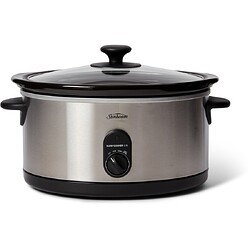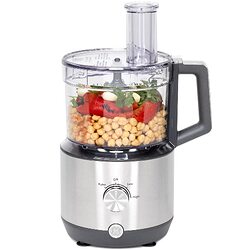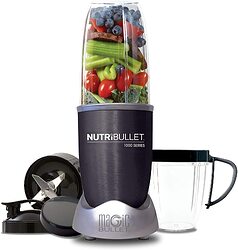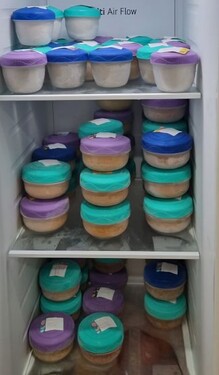Food is such an overwhelmingly important part of our lives. Of course we can’t live without it, but it is also part of our identity, our connection to family and social activities and an important part of our home life in general.
Sometimes our choices can be limited by factors that are not always in our control like finances, availability, allergies etc. It can be very hard for a lot of people to transition to modified foods as you need to get used to new textures, tastes and ideas around what food should be to you. Some people start out on modified diets before having the opportunity to try certain foods as well. This can feel just as isolating when people around you are eating differently to you.
Today we are looking at one limiting factor, and that is swallowing difficulties resulting in someone needing to be restricted to a pureed diet. For the aficionados in the group with experience with the pureed diet, you can skip to the end for some recipe suggestions.
What is a pureed diet?
A pureed diet is a diet modified so that all food is blended to a smooth consistency. I am sure quite a few of you will be familiar with the chart below demonstrating the main options when it comes to modified food textures.
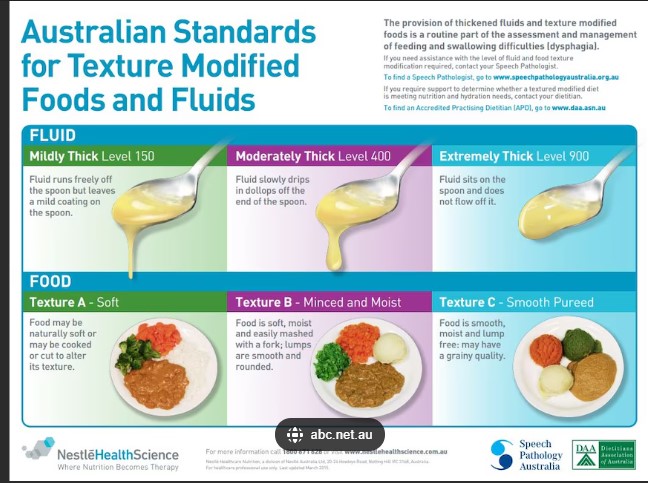
Different people require different levels of modification in order to safely swallow their food. When assessed people are assigned a diet level in order for carers to determine how thick their food needs to be.
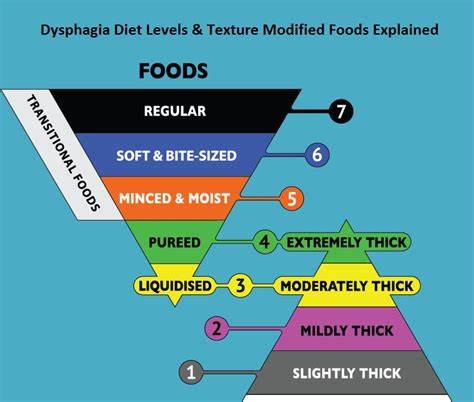
What can cause someone to need a pureed diet?
Once someone reaches a stage where their ability to safely swallow solid food without choking and liquids without coughing becomes impaired they need to be assessed to determine if they need a modified diet. Many conditions can cause the muscles that control swallowing to weaken. Acid reflux, aging, ABI, cancer treatments, degenerative disorders and physical injuries to the head and neck are just a few of those conditions.
What are the risks of someone who requires a pureed diet eating solid foods?
The biggest risks are choking and also pneumonia caused by fluid and food in the lungs. There are several clips on youtube showing x-rays demonstrating what is happening to food and liquid when someone is not swallowing properly. I do like this one as it shows a normal swallow compared to someone who is unable to properly swallow.
As you will see, fluid quite easily goes into the lungs when it is not thick enough for the person with the swallowing difficulty.
Once someone is at this stage it is important to have them start eating a modified diet as soon as possible. So the next step is deciding to home cook or buy premade.
The pro’s and con’s of prepackaged pureed foods.
There are a small number of companies that specialise in premade pureed foods. There is a tendency for these to be aimed at babies or the elderly which can limit options and flavours. There is also a tendency to have one flavour per item. This can cause them to be a bit bland sometimes. It can also result in them all being the same colour when mixed together which is usually not an appetising shade of brown. The cost can be a little prohibitive unless you buy in bulk. On the upsides there is very little prep time, they are easily stored flat in the freezer, they generally have very good consistency and they come with expiry dates.
The pro’s and con’s of home made pureed foods.
When it comes to home made foods, they can be much more cost effective as you are using standard ingredients and you can also tailor the flavours to suit you. There are also now more recipes available thanks to more people following bariatric surgery diets and diets for other conditions. You can cook large batches and separate into containers to freeze for later use to save some time cooking. The down sides can be trying to get the right consistency (not too lumpy or watery, no ingredient separation), the prep time, the clean up and storage strategies if you don’t own a lot of tupperware in the sizes you need. You also have to try to ensure that the diet is balanced with the right amount of calories, carbs, proteins and vitamins. You also need equipment.
What equipment is most commonly used to create pureed foods in the kitchen?
Beyond your standard pots and tools (and some AT mentioned in Edible Education, Everyone Can Cook (a few recipes included)), having a slow cooker, a food processor and a small batch blender in your kitchen can make pureed cooking a lot easier.
Being able to grind foods down, poach them to prevent meats from getting tough and blending them for easy pouring can make the process much easier.
The other thing you will need is tupperware. Tupperware comes in different sizes. You can make things a lot easier by measuring how much the person on the pureed diet is eating in milliliters at each sitting, and buying tupperware that holds that amount. Some people like to buy a meal size and a dessert size option. You can also buy freezer labels to make it easier to name and date food and be removable.
What are the best cuts of meat to use?
Choosing meat cuts is important as different cuts cook differently and some come out tougher to blend into a smooth paste.
Most fish will blend well but make sure there are no fine bones. If you are going with a white fish you may need to poach it and then blend it with something a bit more creamy to stop it having a sandy texture.
With beef it is important to pick cuts that have good fat marbling as they will be least likely to become tough. Some people recommend sirloin but I prefer to work with chuck or brisket in the slow cooker. I will also use these cuts in things like pureed spaghetti bolognaise rather than mince because it is easier for the blender to miss little bits of mince.
With chicken I always prefer thigh meat to breast meat because it has much more flavour when pureed. Some people swear by waiting until it is cold to puree, I prefer to poach it really well and blend with liquid while it is hot until I get the desired consistency. Some recipes are easier if you puree before you cook the meat and in those instances breast meat is easiest.
With pork I prefer tenderloin. It doesn’t have too high a fat content and blends smooth.
Alternatively to all of those you can opt for plant based protein sources, most of which blend into smooth creamy dishes very easily.
Use alternatives to recreate flavours of solid foods.
Sometimes we want tastes, but the flavours disappear when food is blended together or the food does not blend well. When this happens we need to get a little creative. With sweet pie bases for things like apple pie, I use a biscoff spread to get the base flavour without it disappearing behind the apples. With my puree cheeseburger, I tend to use pickle juice instead of pickles to stop the meal being over powered by the beef. With a bit of trial and error you can start to get a feel for how different flavours are interacting in order to make purees that taste closer to the real thing. I also like replacing pasta in recipes with risoni as it is easier to cook and blend.
What can be used to thicken pureed foods?
There are artificial thickeners on the market these can make thickening up meals a lot easier. If you want to use ingredients to achieve this, things like custard, cream, coconut cream, pureed chickpeas, pureed risotto rice, flour and other ingredients can be used to make foods creamier and thicker.
Examples of some of the amazing recipes you can try.
Some one asked me one time if all pureed food was “just soup”. My answer to that is that it doesn’t have to be. You can still get slightly different textures and thicknesses differentiating between soup and food in pureed diets. I also try where I can to make sure the meal contains multiple food groups for a balanced diet. The following are some recipes that I find people enjoy trying out and adding to.
I will say all of the best puree food cooks I know started out their journey somewhere. When I started cooking puree foods 5 years ago my favourite channel on youtube was run by a lady named Sherri Smith. I learned quite a bit from her and some of my favourite recipes I use today are based on a few of hers with alterations that better suit the way I like to prepare puree. (shout out to the channel https://www.youtube.com/@NoChewFood/videos).
One of those recipes is the pureed burger. I use a slow cooker and a blender.
Into a slow cooker:
2 Tbs olive oil
1/2 large onion, chopped
2 garlic cloves, minced
1kg of cubed chuck beef
Salt & pepper
1/4 cup of worchestershire sauce
1/4 cup Pickle juice
1 tbs of mustard
Cook on low for 6 hours.
Transfer the solid ingredients into your blender and add a small amount of the juice to blend. Slowly add juice as you blend until you reach the desired consistency. Someone told me they also blended in some cream cheese to make it have a smoother texture. Remember beef takes the longest to blend if you want a really smooth consistency.
Cashew white sauce and pasta
This one is an option if you want something other than bolognaise on your pasta or want a vegetarian option. It can be a little tricky with a few different things on the go.
Start by boiling 2 cups of cauliflower florets until tender, boiling a cup of risoni and putting 2 cloves of garlic on a tray in the oven to roast at 180 degrees for 20 minutes.
While that’s all cooking, soak 1 cup of raw cashews in hot water for 15 minutes until they go soft.
Once everything is cooked soft, put the cauliflower, risoni, garlic, cashews, a pinch of salt and some basil to taste into a blender and blend until smooth.
Spiced pumpkin puree
This one is one of the simpler recipes.
Boil half a butternut pumpkin, 2 carrots and half an onion all diced for 20 minutes in a pot of water with a pinch of salt. Scoop the solids into a blender without the liquid. Add some milk and butter to smooth out the consistency as you blend. Then season it with turmeric, ginger and garlic powder.
You can also add pepper but be light handed as spicy tends to coat the mouth with pureed food.
Chocolate mousse
This one you will only need a blender. Throw in one 400ml can of coconut cream, one diced avocado, 1 tbsp cocoa powder, 2 tbsp chia seeds, 4 tbsp of pure maple syrup and 1/4 tsp pure vanilla extract. Blend these into oblivion. Once smooth, put it into a container to set in the fridge overnight. You can freeze this recipe and let it thaw out for later use as well.
Sweet pork puree
This will require the slow cooker and blender. In the slow cooker place 2 sweet potatos, 2 apples, 2 carrots, 1/2 an onion, all cubed, and 2 cloves of garlic. Dice 500g of pork tenderloin and place in the slow cooker. Add salt and vegetable or chicken stock to just cover the ingredients. Cook for 6 hours on low. Move the solid ingredients to a blender and add a tbls of butter. Blend the ingredients. Add juice from the slow cooker if needed to make the mix smoother.
Chicken mushroom risotto
To be fair, this is just cooking a risotto and then blending it. It is double handling and is fiddly but it comes out very well. Chicken has a tendency to get dry and crumbly if it is not treated right. It is how you treat the chicken first that makes it super smooth.
Take 2 chicken breasts, dice them into small cubes, lay it all flat in a freezer bag and set it flat in the freezer for about half an hour.
Once the times up, take the chilled chicken cubes and place them in the blender with a splash of red wine (the alcohol will cook off) and 200ml of thickened cream. Blend until smooth. Cook the risotto rice with chicken stock, mushrooms, marjoram, basil and the chicken mix. Once cooked, add the risotto to the blender and blend again until smooth. Add a little more cream if the consistency isn’t quite right.
Hopefully these few examples will get taste buds going. There is a wide world out there for amazing meals and desserts as well as all the tricks and tips floating around.
As always if you have any questions about pureed foods, feel free to ask. Or drop a recipe if you have a really good one.


